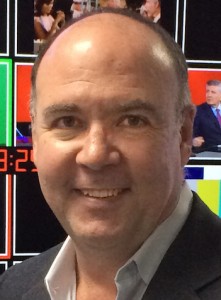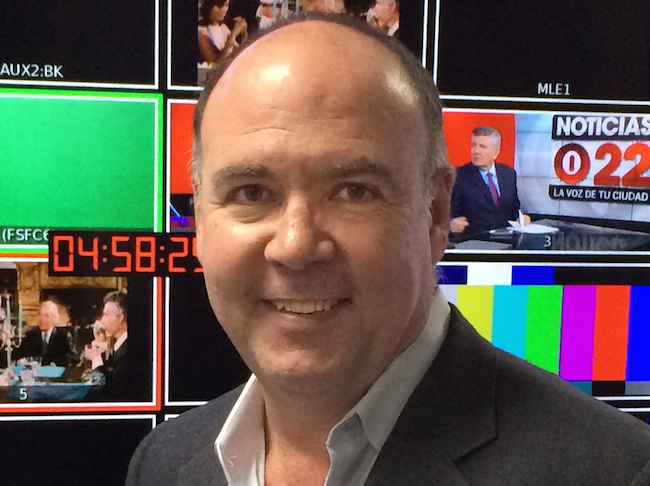
An accomplished programming executive, Rodríguez sat down with Media Moves to share his ambitious plans to turn Super 22 into a superstation with national impact.
What is Super 22?
When KWHY-22 became the flagship affiliate for MundoFox, Meruelo [Media] decided rather than to just shut down the existing channel 22, to move it into the digital slot 22.2 and rebrand it to Super 22.
That’s the channel I’m managing with the intent of using it as launch pad to new national distribution.
Despite the fact it’s on digital distribution, it’s continuing to work, because it has the mix of classic movies and news shows (which air on MundoFox 22) retransmitted there. It continues to perform surprisingly well.
One of the tasks I have is not to abandon that entirely, but to transition it to something bigger.
What’s your first order of business as General Manager of Meruelo Television and Studios?
The first order of business for the last two months has been to determine what is the strategy for this new service, making sure there’s a buy-in for everyone and developing a business plan.
I’ve been meeting with producers to get sufficient content to deliver on the desired position. Then we’re going out on the road to try to get distribution for it beginning in February.
That’s the channel. The other component of the television studios is that although we anticipate a lot of the excess studio capacity we have will be taken up by the new service, we also think we have an opportunity to build a production service business here by advertising locally to producers and production managers that are interested in doing production.
It’s 2000 square foot space that is currently unused. We have control room space, full lighting and equipment packages. That’s another aspect of the business we’re in the process of developing.
Is part of the strategy a rebranding of Superstation 22?
Yes. We’ve come up with name, but we’re still in the process of getting it cleared. We’re not able to announce it yet.
As soon as we get clearance on the name and have the strategy locked in and take it on the road, we’ll be transitioning Super 22 within a 6 to 8 month time frame to a new channel. As distribution rolls out, we’ll be adding new content.

Who will be producing the content?
There will be some portion of the content that will be produced in-house, although my preference is always to work with individual producers, because they can devote themselves 100%.
We can’t be experts in everything. We much prefer to work with creative individuals to do more of that heavy lifting.
I can see in the 2 to 3 year horizon doing shows that we might offer for syndication and export.
Will you be opening the door to independent producers?
We’re already taking pitches; we have started having those conversations.
Do you have a lot of people pitching?
Not as many as I’d like. I’d really like people to be burning up my phone line. I need as much variety as possible.
What kind of content are you looking for?
We’re very interested in things that are home grown. I’m looking for stuff that’s based in Los Angeles that talks about the Southwest Latino experience.
As I look at what’s actually on the dial, there’s a lot of stuff out of Miami and the rest of it mostly out of Mexico. I think that programming based here has an opportunity to be more authentic and more relatable to a greater portion of the U.S. Hispanic audience.
Mostly, I’m looking for reality, documentaries, things that are good positive stories. I’d like to see a greater variety of the population represented on screen.
What is your programming strategy?
We’re taking a cable strategy for our national plans. We’re going to continue serving the Los Angeles broadcast audience by making sure the programs that have worked for them continue to be on the schedule.
But we’re looking to expand the service, looking more in terms of competing in a cable environment. We’ll be more directly targeted. We’ll be more a niche service than a broadcast mass-market service.
Have any providers agreed to carry Superstation 22?
We’re working on it. The first phase is getting 100% carriage in Los Angeles and I’m confident we’ll be able to accomplish this.
Right now we’re on Time Warner Cable and Verizon Fios.
Besides traditional cable and satellite distribution, we’re also talking to new Over The Top platforms. While getting on the cable dial will be difficult or challenging, we’re open to internet distribution as well.
Are you hiring?
We’re definitely hiring. We’re adding significant staff in next 18 months.
A common mistake startup networks make is to build huge infrastructure months before they’re even on the air.
We’re taking a much more incremental approach. We’re bringing people on, expanding as we go, as the business is tracking in right direction. It’s a much better approach to take.
We’ll be hiring for every department of the operations – from marketing and communications, on-air promotion, post-production – everything required to put a network on the air.
A lot of the justification for us to do that is that there’s already an infrastructure in place. We’re not starting absolutely from scratch, so we’ll be adding on to the various departments that support the operation.
How do you envision success for the first Hispanic superstation?
As I build out the business plan, we do it 5 years at a time; it’s an incremental thing. We recognize it’s not the best time ideally to launch anything. Cable operators will say this is last thing we need is more channels.
We understand that this is going to be a long haul. But the way we’ll measure success is first locking down distribution locally, then spreading our distribution. Just getting on one of the major satellite providers, for example, will give us that initial national footprint. Or, if you do a deal with Comcast, automatically, you’re in front of 20 million homes.
I don’t want to minimize the challenge of that, but it doesn’t take too many deals to achieve that first national distribution.
Ultimately, we have an ambition to tell stories that being purely confined to this market [Los Angeles] won’t be possible to do economically. We really need a national footprint in order to justify the kinds of investment we’re anticipating making in programming.
About Rick Rodríguez
He is the General Manager for Meruelo Television and Studios.
Cuban-born and raised in the Bronx and Miami, Rodríguez is a 30-year television production and programming executive who launched his professional career while in college. Inspired to become a writer, he became the editor of the community paper West Kendall Gazette before switching to TV production.
After spending 7 years with Florida’s Dynamic Cable Vision, first in charge of its studio operations and later as Program Manager, he was recruited to Discovery Networks as VP of Programming for Latin America. He went on to hold several roles of increasing importance within the company, including Executive Vice President of Content for Discovery Networks International, overseeing all programming operations in more than 40 countries. He was also General Manager of the Travel Channel U.S. and more recently, President and GM of the bilingual Qubo children’s network.
A self described “super nerd,” on his spare time he runs Surface Pro Artist, a blog for artists using professional 2D and 3D Windows 8.x applications on the Microsoft Surface Pro tablet.





